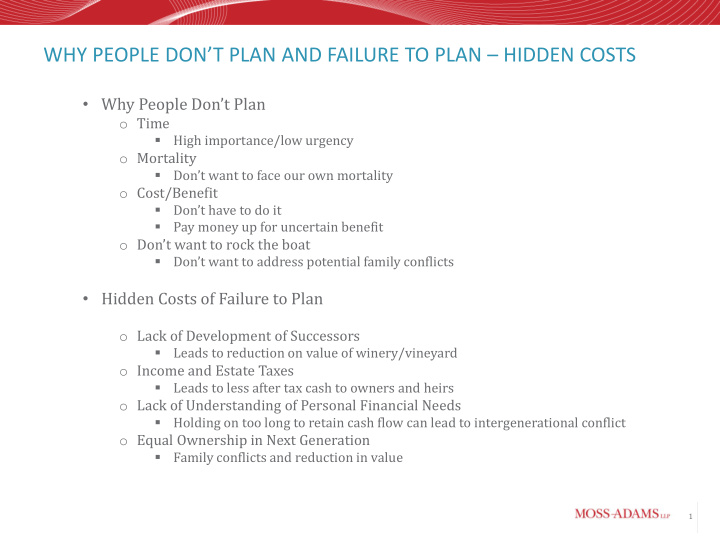



WHY PEOPLE DON’T PLAN AND FAILURE TO PLAN – HIDDEN COSTS • Why People Don’t Plan o Time High importance/low urgency o Mortality Don’t want to face our own mortality o Cost/Benefit Don’t have to do it Pay money up for uncertain benefit o Don’t want to rock the boat Don’t want to address potential family conflicts • Hidden Costs of Failure to Plan o Lack of Development of Successors Leads to reduction on value of winery/vineyard o Income and Estate Taxes Leads to less after tax cash to owners and heirs o Lack of Understanding of Personal Financial Needs Holding on too long to retain cash flow can lead to intergenerational conflict o Equal Ownership in Next Generation Family conflicts and reduction in value 1
SUCCESSION PLANNING PROCESS Integrated Process Steps – Not just an event Business Planning, Management Succession, Ownership Transition, Estate Planning, Personal Financial Planning 1. Who? When? – Attys, CPAs, Trusted Business Advisors, Family 2. Prioritization of goals and objectives – Where do I want to be? 3. Diagnostic (assessment) – Where am I? Business Financial Planning o Management Succession o Estate Planning o Personal Financial Planning o Ownership Transition o 4. Based on where I am – what alternatives are available to me? • Based on prioritized goals and objectives What alternatives are available to me • Consistent with my goals and objectives o Consistent with my business and personal financial health o Consistent with my industry o • If no alternatives are satisfactory Are there things I can do in the short term to accomplish goals o 1. Design – How do I get there? 2. Reviewing the plan 3. Implementation – Getting there? 2
DAUNTING PROCESS Take in steps • If don’t know what exit strategy is, just try and identify and prioritize business and personal goals and objectives and assess where you are relative to those goals and objectives • If you know you are going to sell, concentrate on maximizing value • If you know you would like to transition internally, concentrate on those key areas 3
EXTERNAL OR INTERNAL TRANSITION • External Transition o Am I maximizing value? The Top Line Business Financial Planning Management o Am I maximizing after tax value? The Bottom Line Income Tax Issues – how am I structured (winery/vineyard, S corp, C corp, LLC) Estate and Gift Tax Issues – have I quantified – what am I doing Current income and estate tax law changes • Internal Transition o Personal Financial Planning How much do I need, or want? o Estate Planning Most effective estate and gift tax efficient methods Will ownership deter from management’s ability to run a profitable business? Family squabbles ? o Management Succession Are my children or key employees capable of managing the business? Can they (a) provide cash flow you need and (b) preserve and grow the value of the business? 4
Recommend
More recommend